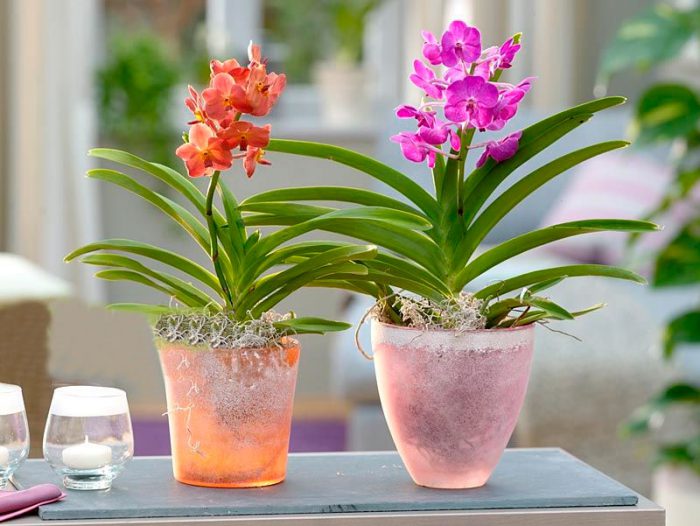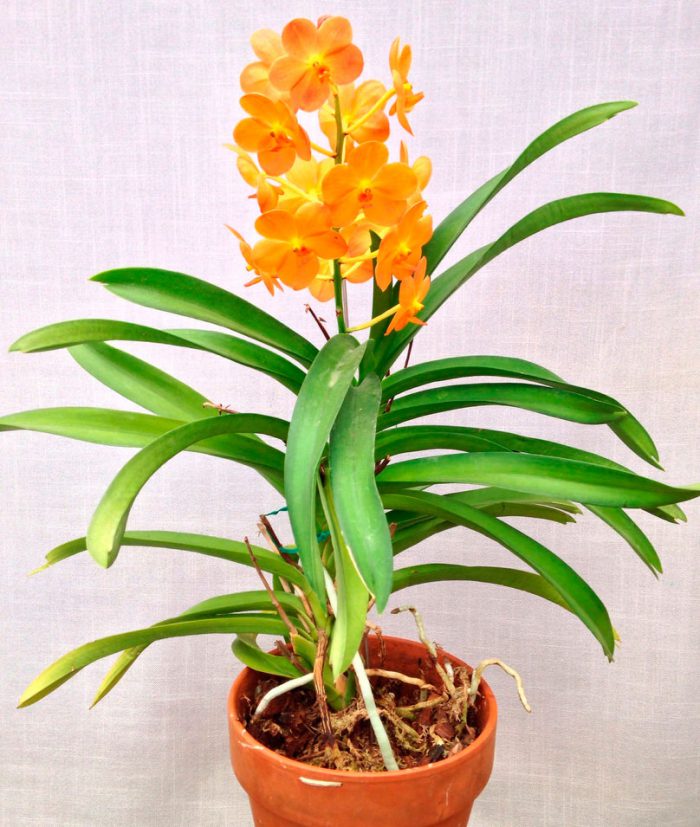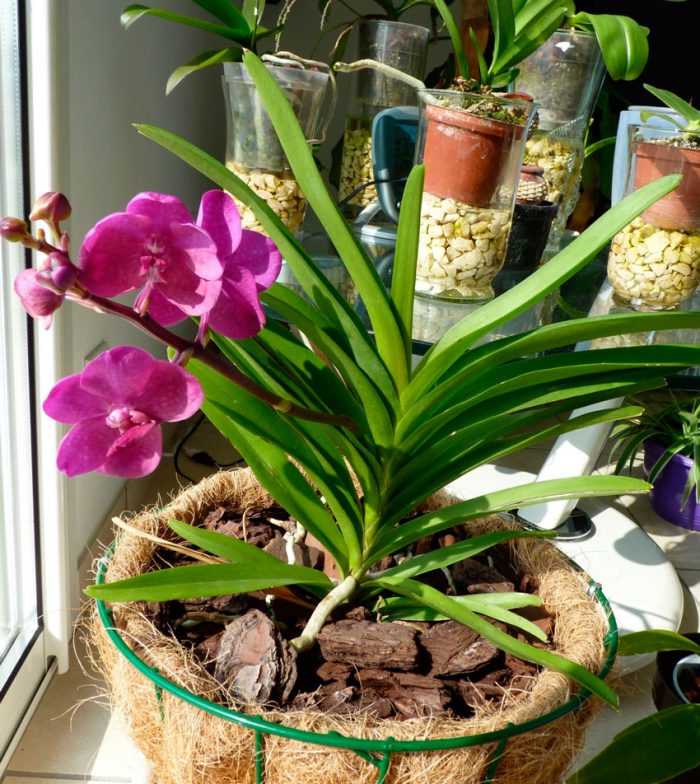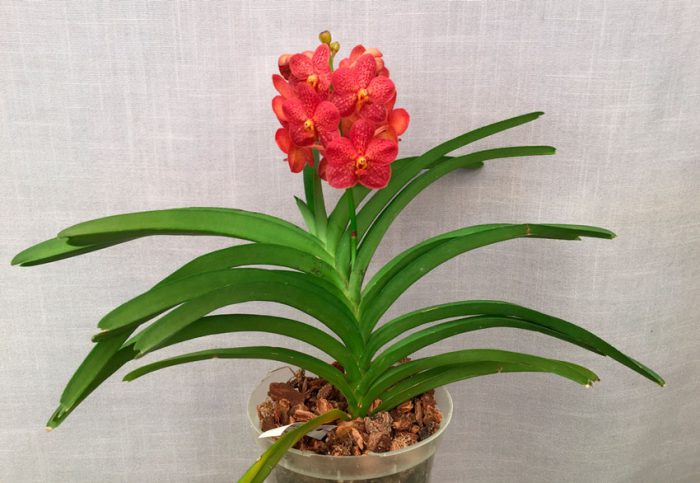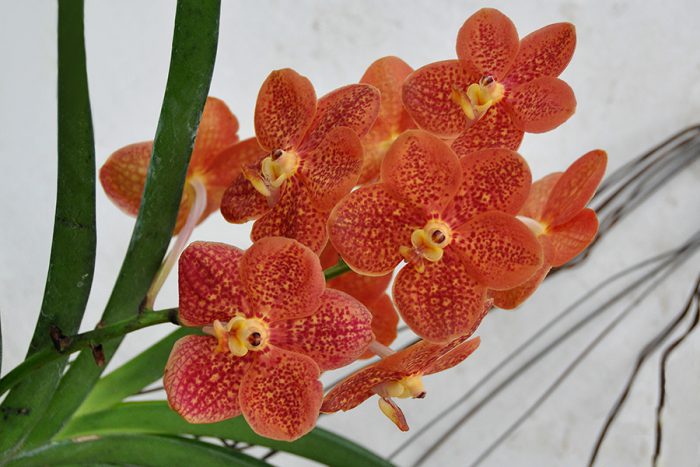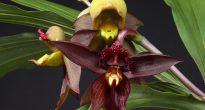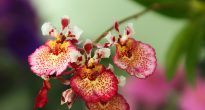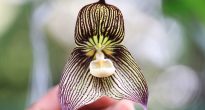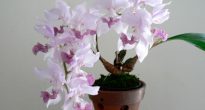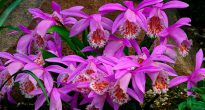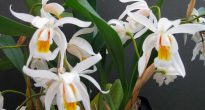Ascocenda (Ascocenda) - this genus, represented by epiphytes, is directly related to the orchid family. It was obtained by crossing various species of Ascocentrum and Wanda. At the moment, this genus unites about 1500 interspecific hybrids (Grex).
The growth pattern of such a plant is monopodial. It has only one vertically located stem. Vaginal, alternate, succulent leaves are placed on it. In these leaves, as well as in the root system, the surface of which is covered with a rather thick layer of porous substance - velamen, there is a supply of liquid that the plant absorbs directly from the air. The foliage is very similar in shape to the wanda. Long, belt-shaped leaf plates are slightly folded along the central vein. Their tips have characteristic bifurcations that divide the leaves themselves into rounded lobes of different lengths.
Flowering is observed from autumn to spring. At this time, the flower has one, and sometimes several multi-flowered axillary inflorescences, which consist of 12-25 flowers of a fairly large size. The flowers of this genus of orchids are distinguished by soybeans in a fairly simple shape, which is similar to pansies (with a slight bowl-like shape), as well as a rich color. The flower itself can be painted in various warm shades from purple and dark red to yellow and orange. The diameter of the flower depends on the hybrid and can be 5-8 centimeters.
Content
Caring for the Ascenda orchid at home
The rules below will help you grow this kind of orchid at home.
Growing methods
There are several ways to grow Ascenda. So, for this they use pots, blocks, baskets, glass vases, and also such a flower can be grown simply in a suspended state with free roots.
Only young plants are suitable for growing in flower pots, whose root system is still very poorly developed. For these purposes, special pots made of transparent plastic are perfect. Additional holes must be made on the walls, as well as in the bottom of the pot, in order to improve air permeability. And for these purposes, a mesh pots designed for flowers are suitable.
The composition of the substrate for a given flower must include sphagnum, pieces of pine or larch bark, and they must be of different sizes 0.5–5 centimeters.Also, the substrate can include "orchid chips" (can be replaced with foam) and fern roots. You can also add a small amount of charcoal and expanded clay.
Experts recommend filling the pot with the substrate unevenly. So, you need to try to have the largest pieces of bark at the bottom of the pot, and small ones at the top. A not very thick layer of moss should be put on top of the substrate, which will reduce the evaporation of moisture and protect the root system from drying out.
It is necessary to plant the ascenda in a basket in the same way as in a pot. To do this, you should choose a basket made of plastic or hard wood, which will help to avoid rapid decay of the container.
For growing this kind of orchid, experienced flower growers recommend using blocks. A piece of deciduous or pine bark of a sufficiently large size is used as such a block. On its front surface, you need to fix coconut fiber, fern roots, as well as sphagnum. On top of this kind of "pillow", the roots of the plant itself are fixed, and already on top of them a thin layer of moss is applied. This unit should be fixed vertically to the wall surface.
The "epiphytic tree" is made in the same way, but here a not very long and rather thick driftwood is used as a block.
It should be noted that a fixed piece of bark or driftwood should be very easily and quickly removed from the wall to water the flower.
The growing method in a tall clear glass vase is gaining more and more popularity among orchid growers. Ascocendum in such a container grows and develops quite normally, but you should be very careful when placing the root system in a vase, as it can be damaged quite easily. It should also be remembered that the green part of the flower must be above the edge of the vase. In order to avoid the fall of the flower inside, it should be fixed. To do this, it can be clamped on both sides with chopsticks.
Also, the ascocendum can be simply hung on the wall and its roots can be left hanging freely. This growing method is the simplest and it is usually used in industrial greenhouses.
Illumination
A certain level of illumination is not required for such a plant. So, it feels quite comfortable both on the window of the northern and southern (shading from the midday sun is necessary) orientation. But there is one nuance here, namely, the illumination should be at the same level all the time without drops. In the cold season, the plant must be supplemented with phytolamps, while the daylight hours must have a duration of at least 12 hours. Additional lighting is also recommended in summer, when the weather is very cloudy outside.
If there is too much light, then the leaves will become reddish and wrinkled, and if there is not enough light, then they will acquire a dark green tint.
Temperature regime
The temperature regime of this plant is closely related to the level of illumination. The lighter in the room, the higher temperatures you need to grow Ascocenda. So, the recommended temperature during the day is from 23 to 27 degrees, at night - from 16 to 22 degrees. Moreover, this temperature regime must be maintained throughout the year.
In winter, you should be extremely careful not to allow the temperature in the room to be less than 16 degrees. During airing, you need to protect the flower from streams of fresh cold air.
How to water
It is recommended to use the immersion method for watering. The container is filled with liquid, and then the flower itself or a container with it for half an hour is carefully lowered into it. During this time, the root system must have time to be saturated with moisture. It should be remembered that the velamen covering the roots should at the same time acquire a green tint instead of grayish-silver (in a dry state) and swell.
How often a given orchid should be watered has a direct relationship with the growing method. When growing in a pot in a substrate, pay attention to the bark. After it becomes solid and similar to dry, it will be necessary to water. In the basket, you can check how wet the bark is with your hands. Both in the first and in the second case, it is necessary to water only after the substrate becomes completely dry.
The most frequent watering is required for a plant grown with free roots. In this case, you need to pay attention to the state of the root system. After the surface of velamen wrinkles a little, it is necessary to water it. However, this method of growing often requires daily watering.
For moistening with a sprayer, as well as for irrigation, you need to take well-settled, soft water, which should be at room temperature. In the case when water from the water supply system is additionally processed, before entering the pipes, it is recommended to filter it.
Humidity
High humidity is required. So, in the daytime it should be maintained at a level of 60 to 80 percent, and at night - from 50 to 60 percent. It is recommended to use all available methods to increase air humidity. So, you can use household steam generators and humidifiers, systematically moisten the foliage, place an open container with water in the immediate vicinity of the flower, and also pour wet expanded clay into the pan. But it should be borne in mind that it is possible to moisten the plant from the sprayer only if there is good air circulation in the room, because the liquid should evaporate from the leaf sinuses as soon as possible. With prolonged and frequent stagnation of water, rot can form in the leaf axils, and this most often entails the death of the ascocendum.
Ventilation
Damp and warm air should never stagnate in the room. But it should be remembered that the plant reacts extremely negatively to drafts and wind. Therefore, it must be removed away from the open window, and also protected from air flows coming from the switched on fan. And when placing it on the balcony, it must be protected from strong gusts of wind.
Fertilizer
It is recommended to feed the plant during watering. To do this, use a specialized orchid fertilizer available from your flower shop. It is recommended to use only one third of the recommended dose on the package. The higher the fertilizer concentration, the longer the break between fertilizing needs to be done. As a rule, fertilizers are applied every 2–4 waterings. If desired, it is possible to alternate root and foliar dressings, while spraying should use a weak nutrient solution.
Features of flowering stimulation
Despite its comparative unpretentiousness, in order for such an orchid to have flower stalks, a number of conditions will need to be met. So, she definitely needs the difference between daily temperatures, while it should be within 2-3 degrees. In the absence of flowering, such a difference is increased to 5-7 degrees. You can also stimulate flowering by reducing or increasing the duration of the standard daylight hours (from 12 to 14 hours) by a couple of hours. Also, for this purpose, a reduction in the number of waterings by 1.5-2 times is used.
Such methods are considered stressful. For the same purposes, you can use specialized chemical stimulants - cytokinins. However, they should be used with extreme caution, because overfeeding is detrimental to the plant. If this happens, then, as a rule, the lower leaves of the flower will begin to turn yellow and die off.
Diseases
The most common non-viral diseases such as a variety of rot.At the same time, the growth point, the places in which the leaves and peduncles are attached to the shoot, the root system and the stem can rot. The appearance of rot can be caused by stagnation of liquid in the substrate, violation of the water regime, stagnation of liquid in the leaf sinuses after moistening from the sprayer.
If the lesion is not very strong, then the places of decay must be removed by cutting or cutting them off. And also treat the damaged area with Fundazol or Benlat. If there is a lot of rot, then it is impossible to get rid of it and, as a rule, the flower dies. It is recommended to prevent the formation of rot by observing all the rules for caring for the ascocendum, as well as regularly examining the bush in order to timely identify the onset of the development of the disease.
Pests
Most often, the plant can settle scabbards, and spider mites... When pests are detected, a hot (about 45 degrees) shower is arranged for the plant. It is also recommended to remove the shield from the surface of the flower with a cotton swab dipped in an alcohol-containing solution. In the event that these measures were not very effective or the flower is quite large, it is necessary to use insecticidal preparations of the appropriate action.
Reproduction methods
Can be propagated by seeds and babies. So, babies appear on peduncles. It is recommended to separate only a rather large, viable baby with a developed root system. But in order for a baby to grow from a flower bud, as a rule, it is required to be treated with a special chemical agent. In this regard, it is unlikely that you are lucky enough to take the baby ascocendum from someone you know.
Only enthusiasts or specialists can propagate this flower by seeds. How to do this can be found in the specialized literature. But it should be remembered that from the moment of pollination to the deposition of seedlings, as a rule, 2 years pass.

